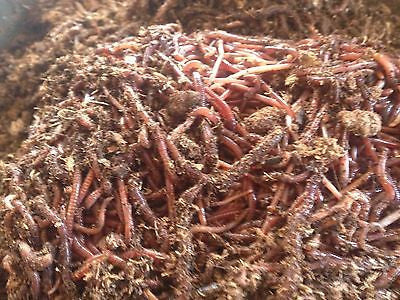Whatever You Need to Understand About Red Wigglers for Composting
Red wigglers, or Eisenia fetida, play a crucial role in the realm of composting, transforming natural waste into useful dirt amendments. Their one-of-a-kind biological qualities enable them to prosper in numerous problems, making them a suitable option for both newbie and knowledgeable composters alike. Comprehending their demands and advantages is essential for developing an effective vermicomposting system. The process of setting up a worm bin and preserving it can posture challenges. To effectively harness the potential of these worms, one have to check out the ins and outs of their treatment and administration.
What Are Red Wigglers?

Belonging To The United States and copyright, red wigglers are surface-dwelling organisms that prefer wet, warm habitats rich in breaking down natural issue. Their diet plan consists mostly of rotting plant product, food scraps, and other natural debris, which they consume and break down successfully. As they absorb this product, they create nutrient-rich spreadings that improve soil fertility.
Red wigglers are hermaphroditic, having both male and female reproductive organs, and can replicate quickly under optimum problems. On the whole, red wigglers are vital contributors to the procedure of recycling natural waste into important compost.
Benefits of Using Red Wigglers
Using red wigglers in composting systems uses many advantages that boost both the efficiency of waste administration and the top quality of the resulting compost. These worms, medically referred to as Eisenia fetida, are especially effective at breaking down raw material, transforming kitchen scraps and yard waste right into nutrient-rich compost at an increased rate.
One of the main advantages of using red wigglers is their capability to eat big quantities of natural material, frequently refining their weight in food waste daily. This high usage rate leads to faster disintegration and minimizes the volume of waste sent out to land fills. Furthermore, the spreadings produced by red wigglers are rich in important nutrients, advantageous microbes, and enzymes, making them a superb plant food for yards and plants.
In addition, red wigglers flourish in a selection of settings, making them adaptable for both interior and exterior composting systems - red wigglers. Their presence in a garden compost container assists to freshen the material, stopping odors and advertising a healthy composting process. Overall, using red wigglers not just adds to reliable waste monitoring yet also supports lasting gardening methods via the manufacturing of high-quality compost
Establishing Up Your Worm Bin
To efficiently set up a worm bin, it is necessary to choose an appropriate container that satisfies the requirements of red wigglers while providing a favorable setting for composting. An ideal container can be made from plastic, timber, or metal, with an ability of at the very least 1 square foot for every pound of worms.
Make sure the container has ample drainage openings to stop excess wetness, as red wigglers prosper in a moist, however not waterlogged, setting. red wigglers. The bin must likewise be aerated to supply enough air movement, preventing anaerobic conditions that can damage the worms
A perfect place for the worm bin is an amazing, dark area, devoid of direct sunshine and severe temperature levels, as red wigglers choose a temperature series of 55 to 77 degrees Fahrenheit.
Prior to presenting the worms, prepare bed linen products such as shredded paper, cardboard, or coconut coir, which will certainly provide both environment and food. Dampen the bed linen lightly to develop an inviting setting for the worms. Lastly, think about putting a lid on the bin to maintain moisture and lower insects, while ensuring it can be conveniently removed for upkeep.
Feeding and Treatment Standards
Feeding red wigglers is an important facet of keeping a healthy and balanced composting system. These worms grow on a diverse diet plan, mostly composed of natural products such as vegetables and fruit scraps, coffee premises, and crushed eggshells. It is vital to avoid feeding them meat, dairy products, and oily foods, as these can create undesirable smells and bring in pests.
When introducing food to your worm bin, cut or shred products into smaller sized pieces to promote quicker decomposition. Begin with percentages to determine the worms' consumption rate, slowly increasing the quantity as they adapt. It is suggested to alternate feeding locations within the bin to motivate complete mixing and oygenation of the garden compost.

Troubleshooting Common Issues
Preserving a prospering worm composting system can in some cases offer obstacles that need interest and troubleshooting. Common concerns include an unpleasant odor, which typically shows overfeeding or the existence of anaerobic problems. To treat this, decrease the amount of food added and guarantee proper oygenation by mixing the bed linens product.
An additional constant trouble is the retreat of worms from the bin. This can happen due to extreme wetness or unsuitable ecological problems. Routinely examine the moisture levels, going for a wet however not soaked consistency, and preserve optimal temperatures in between 60-80 ° F(15-27 ° C )to produce a comfy environment for your red wigglers.
Bugs, such as fruit flies, can additionally attack worm containers. red wigglers. To battle NC Worm Farms this, cover food scraps with a layer of bedding or shredded paper to deter flies from laying eggs. Furthermore, make sure that any food added is fresh and without mold, which can bring in unwanted insects
Lastly, if your worms seem non-active, check for stress aspects such as temperature changes or poor wetness. Attending to these common issues will certainly help maintain a healthy and balanced and productive worm composting system.
Verdict
In recap, red wigglers, or Eisenia fetida, play an essential function in sustainable waste administration through vermicomposting. Appropriate setup and upkeep of a worm container, along with adherence to feeding standards, ensure a growing ecosystem that decreases landfill contributions.
Comments on “Red worms: How to raise a worm bin”